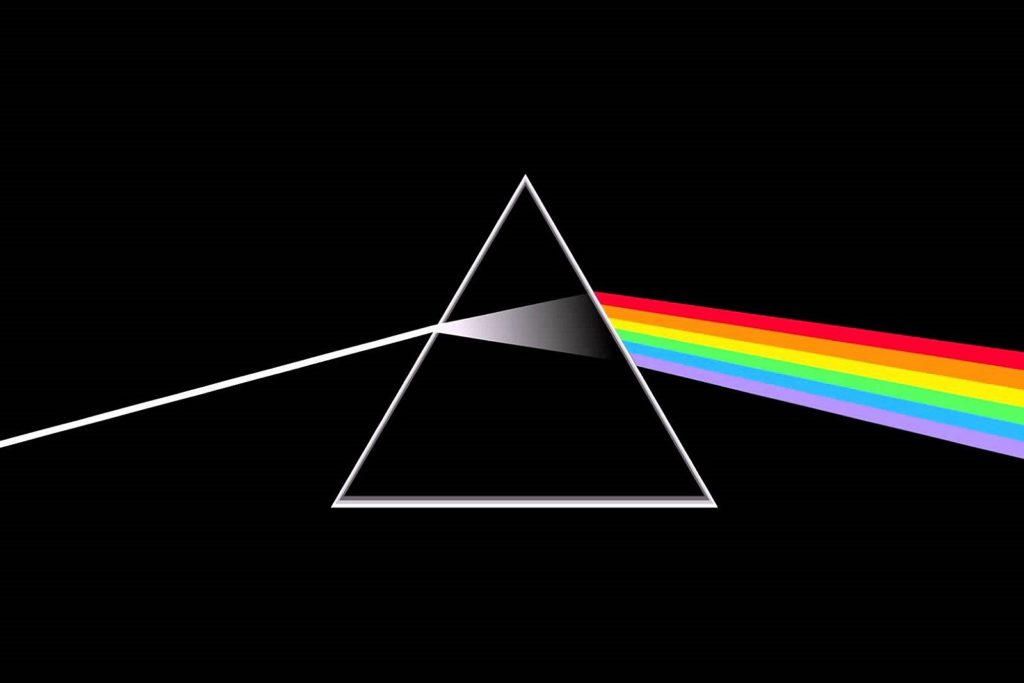The History and Popular Music of the ’70s class learned about Pink Floyd’s monumental record from 1973. Here are some of their reactions.
The Dark Side of the Moon was released by Pink Floyd in March 1973, and only topped the Billboard chart for one week before being displaced by Elvis’ Aloha from Hawaii via Satellite. However, the groundbreaking experimental rock album did not drop off the charts completely until an incredible 740 weeks later. Dark Side has spent more time on the charts than any other album in history; so what was it that made the album continue to find thousands of new listeners every year after its release?
Side one of Dark Side paints the picture of a life unfulfilled. The opening track, “Speak to Me,” seems incoherent on first listen, featuring helicopter whirring, screams and an alarm clock. The track, however, connects with nearly every other song on the album. Most tracks, although complex, can be reduced to a single sound effect, which are all crammed together on “Speak to Me.” The first track blends seamlessly into the serene “Breathe,” which introduces the listener to a world where there are two options. You can do what others tell you, and “ride the tide,” or you can go against the grain and “choose your own ground.” “On the Run” is an instrumental track with the message that, regardless of the choices you make, life is stressful and chaotic. The song tries to reproduce the feeling of anxiety with a chaotic synthesizer, maniacal laughing, and airport announcements. “Time” is one of the most impactful songs on Dark Side because it deals head on with the fear of wasting one’s life. With an alarm clock intro, the track is quite literally a wakeup call to anyone not living their life to the fullest. It carries the message that you cannot wait for “someone or something to show you the way,” you have to make meaning for yourself. The instrumental build up to David Gilmour’s dramatic vocals at the start of the track and the guitar solo at the mid mark make it one of the most memorable songs from the album. The final track on side one, “The Great Gig in the Sky,” addresses the most terrifying concept of all for humanity: death. At times Clare Torry’s wails on the song sound defiant and unafraid, at others frail and scared, representing peoples’ different outlooks on death. Her unbelievable delivery and the heart-wrenching piano backing make “The Great Gig in the Sky” the most likely song from Dark Side to bring you to tears.
Side two of Dark Side illuminates the various things that cause people to be anxious, waste their time, hurt others, and die unfulfilled. The song “Money” kicks off the second side, and serves as an indictment of wealth and its pursuit. Some people spend their whole lives trying to accumulate riches, often fighting others for it, only to end up with a number. This song has a more bluesy feel and features both a funky sax solo and driving guitar solo. Ironically, “Money” is the most popular single from the album and was partially responsible for their immense wealth. The spoken word segment at the end of the track connects money with conflict, leading into the next song “Us and Them.” The lyrics of this track cry out against war, classism and racism, mocking their arbitrary divisions. “Black and blue, and who knows which is which and who is who.” In a conflict people are convinced that they are forced to pick between two choices when really many more exist. The crescendos composed of saxophone, guitar, and organ bring startling intensity to an otherwise jazzy and subdued track. “Any Colour You Like” is the only purely instrumental track on the album, so its meaning is harder to discern, however its title suggests a continuation of the themes of “Us and Them.” You can choose any color you like, as long as it is one of the two colors offered. “Brain Damage” is about insanity and the consequences of going against mainstream society. Another extremely consequential lyric appears near the end of the song: “And if the band you’re in starts playing different tunes… I’ll see you on the dark side of the moon.” This is likely in reference to former band member Syd Barrett, who would sometimes start playing a completely different song from the rest of the band while on stage. Dark Side is punctuated with the epic closer “Eclipse.” The repetitive lyrics and grand soundscape give the song a feeling of universality and finality. It is at this point that the thesis of Dark Side becomes clear: madness is inescapable. Joining the rat race, mindlessly fighting in a war, and letting others tell you what to do is insanity. Going against society and alienating yourself from everyone else is also insanity. The Dark Side of the Moon is madness, something which is always there yet invisible. Eventually, The Dark Side of the Moon will block out the sun, which represents the normal and positive emotions experienced in life. One can only hope that, like in an eclipse, the moon will eventually pass.
Dark Side found popularity because of its highly thought-out concept which is supported by deep and universal themes, resulting in a profound relatability. Just like its album cover, Dark Side is simple and bold. The album is fundamentally about one human life, and the trials and tribulations that are faced by a person, which inevitably drive them to madness. – Jasper Selwood
I based my response mostly off “On the Run.” I had the biggest reaction to that song. Although I liked it (and the album in general) I got a very unpleasant and uneasy feeling from it. When I did my response I just drew the first thing that came to mind and represented my feelings towards it, which was the feeling of being watched when you’re alone. – Paloma Thrailkill
– Zadie Niedergang
Dilapidated Time
An overtaxed clock
Ticks away at time
Solitude waits to pounce
Unannounced growls nip at the hour hand
Reaching for fictional hope
Hope fizzles
Shriveled under the scathing sun
A melodic ticking time bomb waiting to devastate
To flee is a fool’s dream
Salted sweat clinging to uncertain ground
Sinking into salted seas
Seas of melted time
He clings to mystic hope that welcomes fear
Afraid of 21, 35, 47
Will he ever sink his dagger into time
Check the pulse
It’s still the same
Or does the heart only paralyze at 12
Maimed by quiet desperation
Cursed by a fatal grasp
Where will he find the terrain of certain ground?
How will he see through the lines of palimpsest scrolls?
Flares flood the sky in an incandescent glow
The sea is empty
Closing in on subtle death
A return to an amniotic home
Aching toes clutch the ground
Time solemnly surrenders
His eyes, grey
His skin, exhausted
Thinning hair leads him towards fleshy decomposition
His narrowing ear canals only pick up subtle ticks
His heart follows the second hand
His eyelids soften
Lips are pale grey
For the first time
The distant call of the clock
Is now replaced by unbearable silence
This poem represents our struggle with the ever continuing time. If you didn’t guess already, I responded to the song “Time” by Pink Floyd. My poem details a story of age; of terror and loss. The song “Time” unearths the threat of a constraint holding us down. We feel free, until we remember time. The first stanza illustrates the realization of a poisonous clock. We see loss and a beginning to decay. The second stanza holds devastation and terror. The uncertainty and denial of a dwindling soul. The third stanza invites ghostly fear. Will he be able to ignore the clock as he did when he was younger? Or does it lurk in his shadows? He can’t kill time as he used to. The fourth stanza releases an eager escape. He yearns to find a cure for this lack of time. A certain fate. The fifth stanza reveals a last call for hope. He has used all his flares. However, he finds a slight calm in the storm. He examines the glowing sky and acceptance to loss. The sixth stanza shows age. Time is getting tired of ticking. He loses the blaring click of the clock. His heart has mere seconds, it follows the clock diligently. The final stanza unleashes death. He finds peace. However, the silence is damning. Why did he spend his whole life chasing time? Anticipating the inevitable? He forgot to live. And the silence is killing him all over again. – Ingrid Lam
While listening to this album I was often fascinated by its importance to teenage boys. For my response, I created a typical teen boy bedroom cramped with stereotypical items. Because The Dark Side of the Moon discusses madness and distress, I thought this representation of the album would be fitting. In the room there is a poster of the album cover along with other posters from famous artists such as the Rolling Stones, Nirvana and Elliott Smith. I chose to add these artists because their music speaks about madness, depression and feeling lost. They are also artists that many teen boys identify with. There are hidden symbols throughout the room that represent the sense of rebellion, resentment and insanity, all corresponding themes I picked up on while listening to the record. The pill bottle on the bedside table represents mental health struggles. The clothing on the floor next to the empty laundry hamper represents rebellion. The mattress on the floor without bed sheets represents the sluggish and lethargic attitude teen boys often adopt. There is also an overarching theme of the bedroom being a private and representative space for the individual that lives there. Oftentimes I notice that my bedroom’s cleanliness reflects my attitude and mood. When it is messy I feel poorly, when it is clean I am on top of my game. The Dark Side of the Moon represents the parts of our lives that are messy, unkept and secret. I believe that bedrooms, especially teen bedrooms, are a perfect symbol for this record. – Linnea Anderson








Leave a Reply